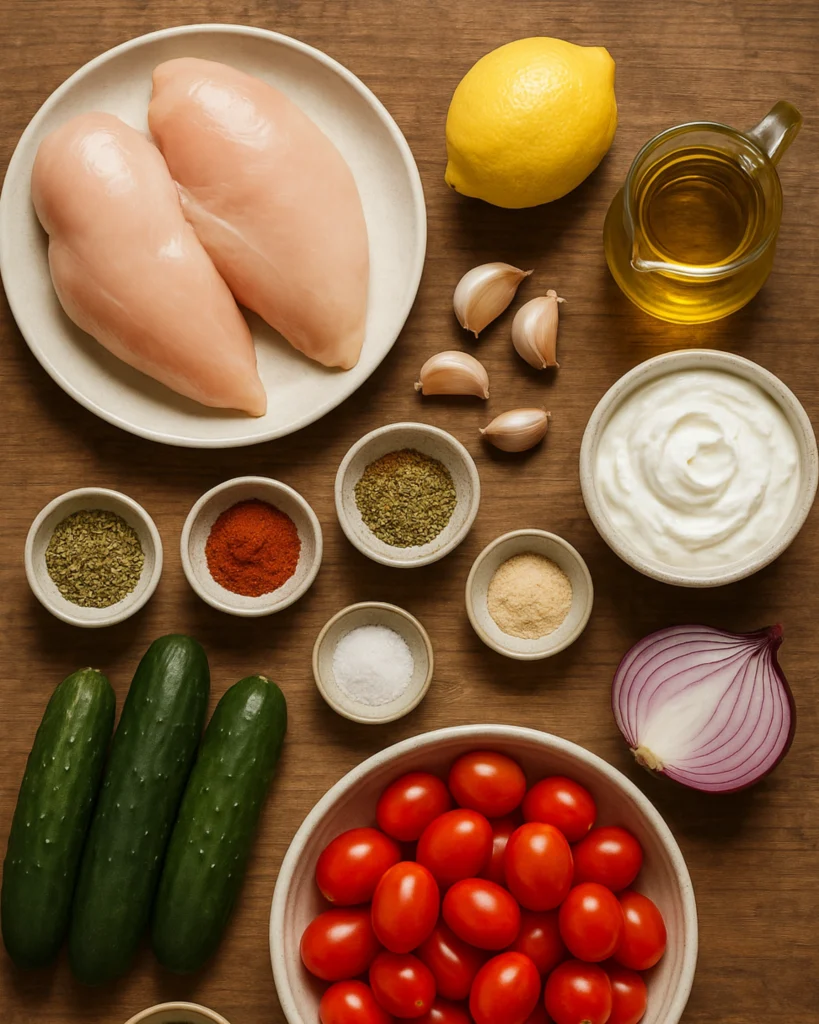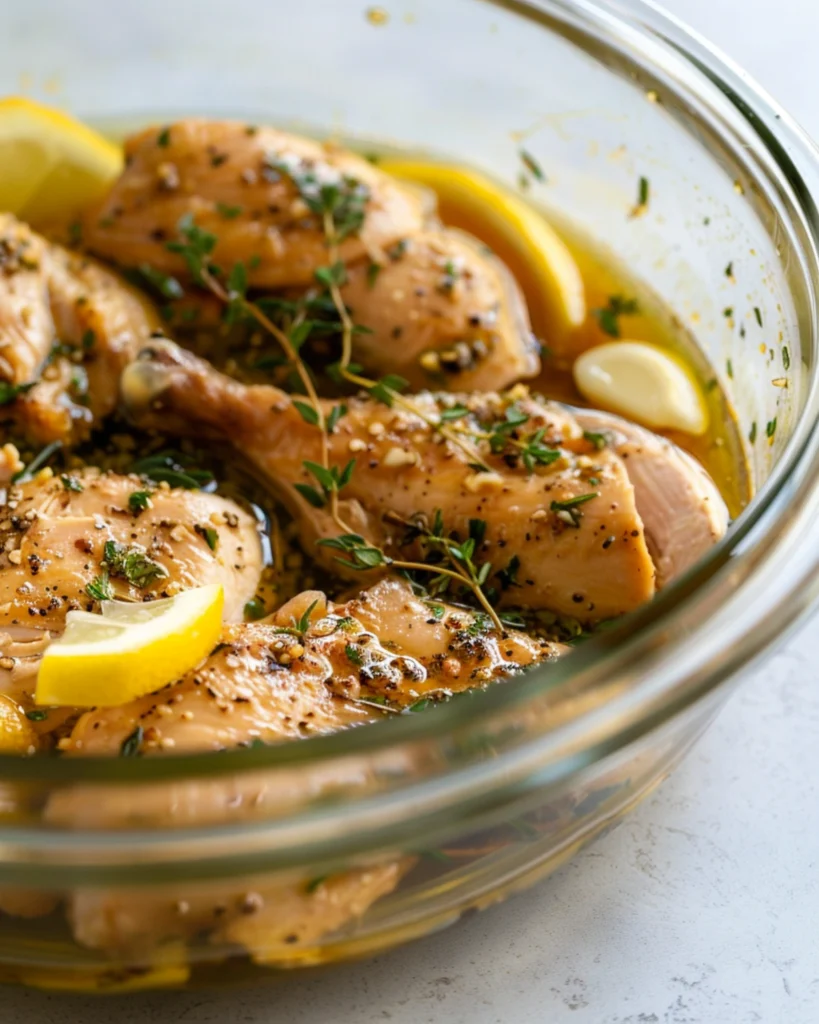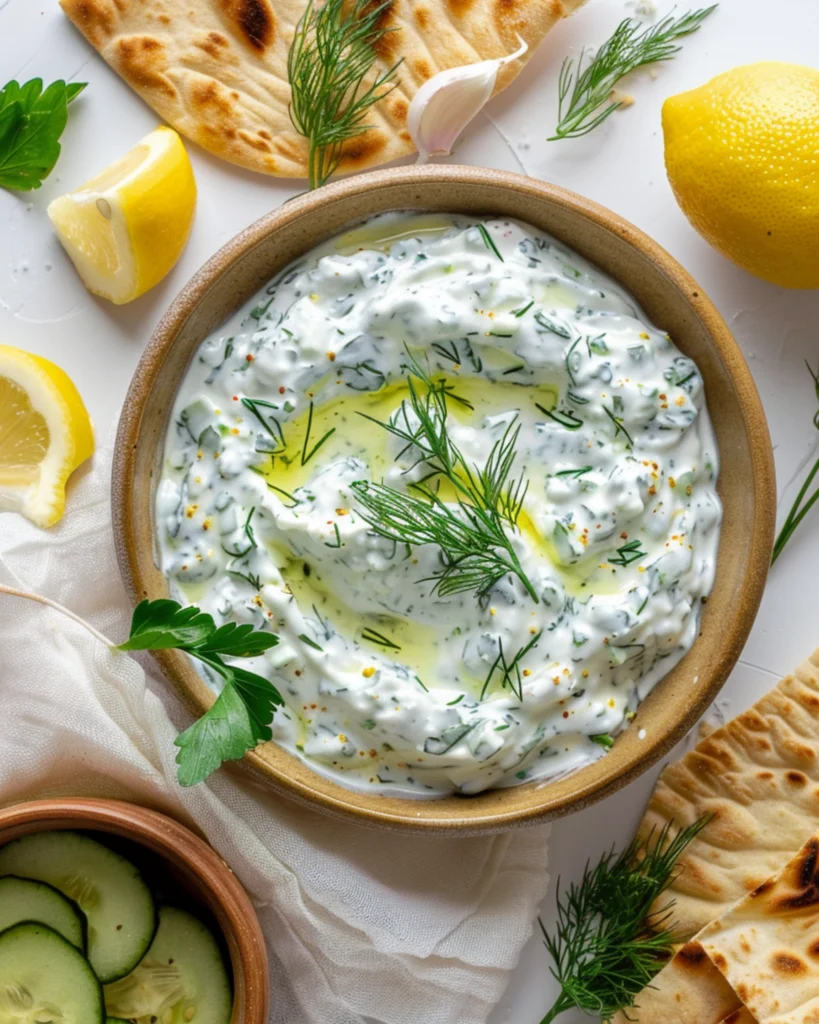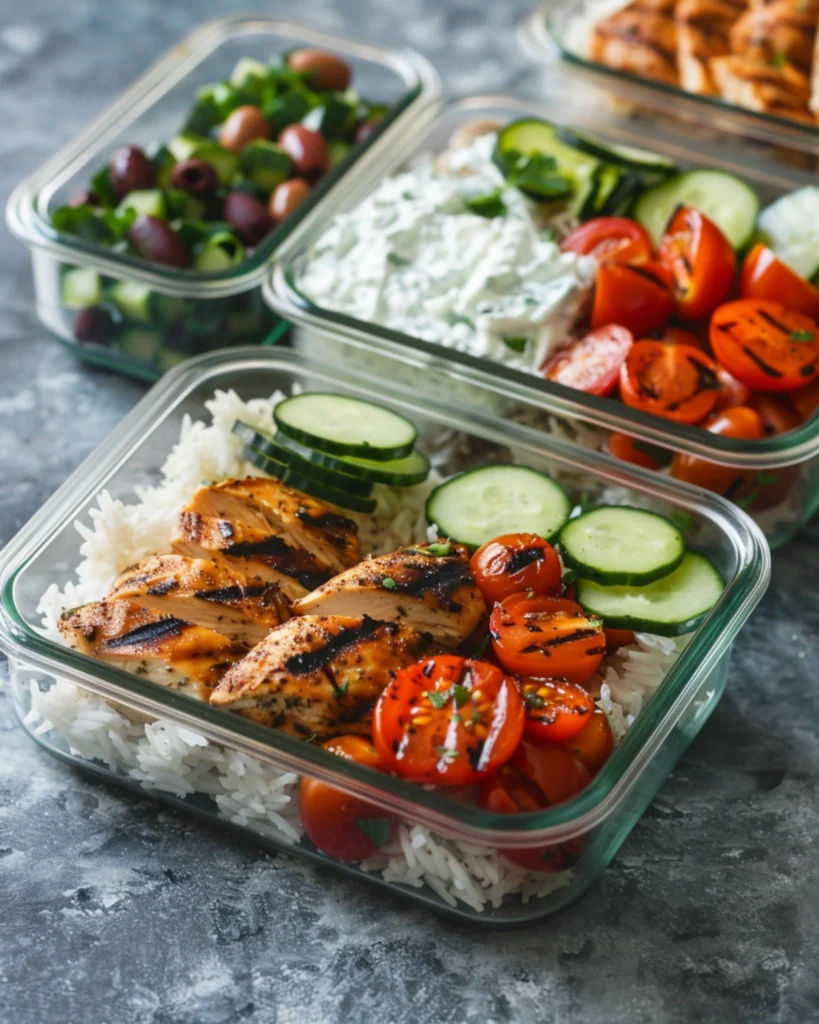If you’re looking for a meal that’s easy to prep, fresh, and full of Mediterranean flavor, Greek chicken bowls are the answer. Whether it’s a busy weeknight or your next meal prep session, these bowls deliver protein-packed satisfaction with tender chicken, vibrant veggies, and creamy sauce—all in one bite.
In this guide, we’ll explore how to build the ultimate Greek chicken bowl, from juicy marinated meat to the best toppings and sauces. Along the way, you’ll also get answers to common questions like “What makes Greek chicken so tender?” and “What sauce goes best in Greek cuisine?” Let’s dive in.
Why I Love Making Greek Chicken Bowls
The story behind the bowl
I still remember the first time I had a true Greek-style chicken dish on a small island in the Aegean Sea. The flavors were bright, clean, and comforting. Tender grilled chicken with lemon, herbs, olive oil, and garlic—it was simple yet unforgettable. Since then, I’ve recreated those memories through my Greek chicken bowls, bringing a taste of the Mediterranean right into my kitchen
Now, Greek chicken bowls are part of my regular meal prep routine. They’re easy to customize, family-friendly, and always satisfying. I love how I can prepare the ingredients in advance and mix and match throughout the week. They’re also a great way to eat healthy without sacrificing flavor or fun. Plus, Greek chicken bowls make a vibrant and beautiful plate—perfect for casual dinners or guests.
What is Greek-style chicken?
Greek-style chicken is typically marinated in a combination of olive oil, lemon juice, garlic, oregano, and sometimes yogurt. The marinade helps tenderize the meat while infusing it with bright, herbaceous flavor. The result? Juicy, flavorful chicken with a golden finish—perfect for pairing with rice, greens, or pita.
For an equally satisfying flavor profile, check out this balsamic chicken marinade or the bold spice in this black pepper chicken.
Key Ingredients for Building Greek Chicken Bowls
What makes Greek chicken taste so good?
The secret to irresistible Greek chicken lies in its traditional marinade. A blend of olive oil, lemon juice, garlic, oregano, and a pinch of sea salt creates a deeply flavorful base. Adding yogurt helps tenderize the meat even more, thanks to its enzymes and slight acidity. The result? Juicy, herbaceous chicken that’s both vibrant and savory. You’ll know it’s working when the aroma fills your kitchen as it grills.

Marination time matters. For best results, let the chicken rest in the marinade for at least 30 minutes. But if you can, go for 4 to 12 hours in the fridge. This ensures every bite is packed with flavor. This technique is similar to how dishes like creamy pesto pasta or garlic butter salmon rely on bold infusions for standout results.

The best toppings for Greek bowls
A great Greek chicken bowl is a balanced plate—loaded with textures, color, and nutrition. Start with a base: lemon rice, farro, couscous, or quinoa work beautifully. Then layer on grilled vegetables like red onion, eggplant, or zucchini. For crisp freshness, add cherry tomatoes, cucumbers, or spinach. Next comes the creamy element: classic tzatziki, hummus, or whipped feta all bring a rich contrast to the smoky chicken.
Top it off with kalamata olives, crumbled feta, and a squeeze of lemon. If you’re feeling bold, sprinkle za’atar or sumac for an aromatic finish. Add crunch with roasted chickpeas or pine nuts. To complete your meal, serve it with creamy cucumber salad or easy flatbread. These bowls not only taste amazing but store well in the fridge, making them perfect for meal prep. Properly sealed, your toppings will stay fresh for up to 3 days.
How to Cook and Assemble the Perfect Greek Chicken Bowl
Why is Greek chicken so tender?
Greek chicken gets its incredible tenderness from the powerful chemistry of its marinade. This usually includes lemon juice, olive oil, garlic, and herbs—sometimes yogurt. Yogurt is particularly effective because it contains lactic acid and enzymes that gently break down protein fibers in the chicken, allowing it to absorb flavor while becoming soft and juicy. This mild, natural tenderizing method avoids the toughness that can happen with more acidic or rushed marinades.
For best results, let the chicken marinate for at least 2 hours—overnight is even better. You’ll notice the meat becomes more supple and flavorful, especially if using chicken thighs. Grill or pan-sear the chicken over medium-high heat, turning it occasionally to develop a nice char while keeping it moist inside. You can use a meat thermometer to ensure it reaches 165°F at the center.
This method mirrors the balanced, flavor-packed approach found in Mediterranean cooking, where seasoning, marinade timing, and fresh ingredients come together to create unforgettable flavor.

Assembly tips for a restaurant-style bowl
Once your ingredients are ready, assembling the Greek chicken bowl becomes a joyful ritual. Start with a grain or salad base like brown rice, quinoa, couscous, or chopped romaine. Lay your sliced or cubed grilled chicken over the center. Around it, artfully arrange cucumber, cherry tomatoes, red onion, olives, and crumbled feta.
Add dollops of hummus or tzatziki in opposite corners for color and contrast. Garnish with lemon wedges, fresh dill, and a drizzle of high-quality olive oil. This presentation not only makes the dish visually appealing but also enhances the layers of flavor and texture in every bite.
The Mediterranean diet, supported by organizations like the Harvard T.H. Chan School of Public Health, emphasizes fresh, whole ingredients—exactly what Greek chicken bowl delivers. For added variety, pair it with a light lentil soup or a roasted vegetable side for a complete, balanced meal. It’s a nourishing, heart-healthy choice that satisfies with every forkful.

Sauces, Sides & Customizations for Greek Chicken Bowls
What sauce is used in Greek food?
No Greek chicken bowl is complete without sauce, it ties everything together. The most iconic choice is tzatziki, a creamy blend of Greek yogurt, cucumber, garlic, lemon juice, and dill. It’s cool, tangy, and the perfect contrast to warm grilled chicken. Tzatziki adds probiotics and protein while keeping things light.
Other delicious Greek sauces include skordalia (a garlic and potato dip), hummus (chickpea-based, rich in fiber), and tahini yogurt sauce. You can even whip up a quick lemon herb vinaigrette to drizzle over your bowl.

For a fun twist, blend roasted red peppers with feta and olive oil for a smoky, salty red pepper sauce. It’s especially good if you enjoy layering bold flavors.
Creative variations and serving suggestions
One of the best things about Greek chicken bowls is how adaptable they are. Looking for low-carb? Use cauliflower rice or a fresh chopped Greek salad as your base. Want more plant-based options? Swap chicken for grilled halloumi, baked falafel, or even marinated tofu.
You can also mix cuisines. Try adding a spoonful of tahini dressing with roasted sweet potatoes for a Mediterranean-meets-Middle East bowl. Or toss in pickled onions. These bowls are great for families too—set up a build-your-own bowl bar with toppings and sauces in small dishes.
Pair your bowl with crispy Greek-style fries or a side of grilled pita. According to Harvard’s nutrition guidelines, meals like this—with lean protein, vegetables, and healthy fats—support balanced eating habits and sustainable nutrition.


Greek Chicken Bowls
Ingredients
Equipment
Method
- In a bowl, whisk together olive oil, lemon juice, garlic, oregano, salt, and pepper. Add chicken and marinate for at least 30 minutes or up to 12 hours.
- Heat a grill or skillet over medium-high heat. Cook chicken for 6–7 minutes per side until internal temperature reaches 165°F. Let rest, then slice.
- In each bowl, layer rice, grilled chicken, tomatoes, cucumber, red onion, olives, and feta. Top with a generous spoon of tzatziki. Garnish with lemon and fresh herbs if desired.
Nutrition
Notes
From your stove to our hearts
share your delicious take!FAQs About Greek Chicken Bowls
What is Greek-style chicken?
Greek-style chicken is marinated in olive oil, lemon juice, garlic, and herbs like oregano. Sometimes yogurt is added to make the chicken extra tender and flavorful.
Why does Greek chicken taste so good?
The rich, bold flavor comes from a fresh herb marinade combined with citrus and garlic. These ingredients infuse the chicken deeply while keeping it moist and aromatic.
Why is Greek chicken so tender?
The acidity from lemon and the enzymes in yogurt gently break down proteins in the chicken, resulting in juicy, soft meat—especially when marinated overnight.
What does “Greek style” mean?
“Greek style” refers to a cooking method or flavor profile influenced by Greek cuisine. It often features fresh ingredients like olive oil, lemon, oregano, garlic, yogurt, and vegetables.
What sauce is used in Greek food?
Tzatziki is the most iconic Greek sauce, made with yogurt, cucumber, garlic, and dill. Hummus, tahini sauce, and lemon-herb vinaigrette are also common.
Conclusion
Greek chicken bowls aren’t just another dinner option—they’re a balanced, flavorful, and flexible way to enjoy Mediterranean eating any day of the week. From the tender marinated chicken to the fresh toppings and creamy sauces, every bite delivers both comfort and nourishment. Whether you’re meal prepping for busy days or hosting a casual dinner with friends, these bowls let you serve a dish that feels both wholesome and elevated.
The best part? You can personalize them endlessly. Add your favorite vegetables, switch up the grain base, or experiment with sauces. This makes them a smart fit for nearly any lifestyle, including low-carb or high-protein diets.
If you’re inspired to keep exploring vibrant meals like this, don’t miss our refreshing Boursin chicken with garlic and herbs or the crowd-pleasing black pepper chicken. They bring the same satisfying energy that makes Greek chicken bowls a regular in kitchens across the world.
Let your next bowl be bold, balanced, and bursting with flavor just the way good food should be.
